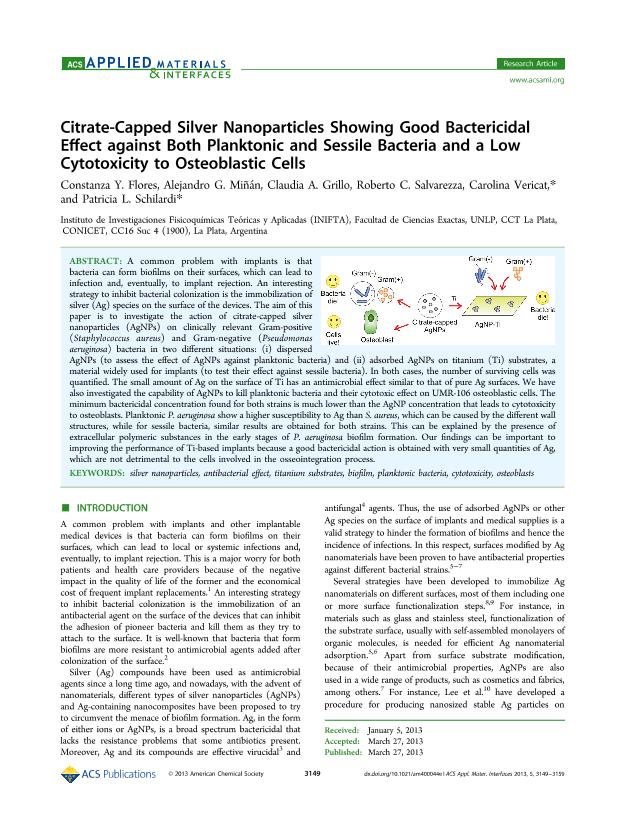Artículo
Citrate-Capped Silver Nanoparticles Showing Good Bactericidal Effect against Both Planktonic and Sessile Bacteria and a Low Cytotoxicity to Osteoblastic Cells
Flores, Constanza Yanel ; Miñan, Alejandro Guillermo
; Miñan, Alejandro Guillermo ; Grillo, Claudia Alejandra
; Grillo, Claudia Alejandra ; Salvarezza, Roberto Carlos
; Salvarezza, Roberto Carlos ; Vericat, Carolina
; Vericat, Carolina ; Schilardi, Patricia Laura
; Schilardi, Patricia Laura
 ; Miñan, Alejandro Guillermo
; Miñan, Alejandro Guillermo ; Grillo, Claudia Alejandra
; Grillo, Claudia Alejandra ; Salvarezza, Roberto Carlos
; Salvarezza, Roberto Carlos ; Vericat, Carolina
; Vericat, Carolina ; Schilardi, Patricia Laura
; Schilardi, Patricia Laura
Fecha de publicación:
27/03/2013
Editorial:
American Chemical Society
Revista:
ACS Applied Materials & Interfaces
ISSN:
1944-8244
Idioma:
Inglés
Tipo de recurso:
Artículo publicado
Clasificación temática:
Resumen
A common problem with implants is that bacteria can form biofilms on their surfaces, which can lead to infection and, eventually, to implant rejection. An interesting strategy to inhibit bacterial colonization is the immobilization of silver (Ag) species on the surface of the devices. The aim of this paper is to investigate the action of citrate-capped silver nanoparticles (AgNPs) on clinically relevant Gram-positive (Staphylococcus aureus) and Gram-negative (Pseudomonas aeruginosa) bacteria in two different situations: (i) dispersed AgNPs (to assess the effect of AgNPs against planktonic bacteria) and (ii) adsorbed AgNPs on titanium (Ti) substrates, a material widely used for implants (to test their effect against sessile bacteria). In both cases, the number of surviving cells was quantified. The small amount of Ag on the surface of Ti has an antimicrobial effect similar to that of pure Ag surfaces. We have also investigated the capability of AgNPs to kill planktonic bacteria and their cytotoxic effect on UMR-106 osteoblastic cells. The minimum bactericidal concentration found for both strains is much lower than the AgNP concentration that leads to cytotoxicity to osteoblasts. Planktonic P. aeruginosa show a higher susceptibility to Ag than S. aureus, which can be caused by the different wall structures, while for sessile bacteria, similar results are obtained for both strains. This can be explained by the presence of extracellular polymeric substances in the early stages of P. aeruginosa biofilm formation. Our findings can be important to improving the performance of Ti-based implants because a good bactericidal action is obtained with very small quantities of Ag, which are not detrimental to the cells involved in the osseointegration process.
Archivos asociados
Licencia
Identificadores
Colecciones
Articulos(INIFTA)
Articulos de INST.DE INV.FISICOQUIMICAS TEORICAS Y APLIC.
Articulos de INST.DE INV.FISICOQUIMICAS TEORICAS Y APLIC.
Articulos(SEDE CENTRAL)
Articulos de SEDE CENTRAL
Articulos de SEDE CENTRAL
Citación
Flores, Constanza Yanel; Miñan, Alejandro Guillermo; Grillo, Claudia Alejandra; Salvarezza, Roberto Carlos; Vericat, Carolina; et al.; Citrate-Capped Silver Nanoparticles Showing Good Bactericidal Effect against Both Planktonic and Sessile Bacteria and a Low Cytotoxicity to Osteoblastic Cells; American Chemical Society; ACS Applied Materials & Interfaces; 5; 8; 27-3-2013; 3149-3159
Compartir
Altmétricas



